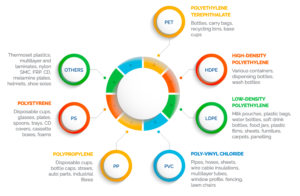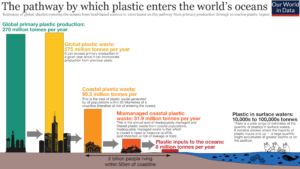ForumIAS announcing GS Foundation Program for UPSC CSE 2025-26 from 19 April. Click Here for more information.
ForumIAS Answer Writing Focus Group (AWFG) for Mains 2024 commencing from 24th June 2024. The Entrance Test for the program will be held on 28th April 2024 at 9 AM. To know more about the program visit: https://forumias.com/blog/awfg2024
Contents
- 1 Introduction
- 2 What is Single-Use Plastic (SUP) and magnitude of its usage?
- 3 What is the current status and coverage of plastic ban?
- 4 How will the ban on single-use plastic be enforced?
- 5 How are other countries dealing with single-use plastic?
- 6 What are the harmful effects of plastic pollution?
- 7 What are the challenges in plastic waste management?
- 8 What lies ahead?
- 9 Conclusion
| For 7PM Editorial Archives click HERE → |
Introduction
Plastic waste management is becoming a challenging task for countries across the globe and India is no exception to it. The use of plastic is on rise while its disposal and safe management hasn’t been commensurate with increased usage. This has resulted in creation of landfills on land and garbage patches in oceans. Considering this, the Government of India has put a ban on ‘Single-Use Plastic’ from July 1 under the Plastic Waste Management Amendment Rules, 2021. The Ministry for Environment, Forest and Climate Change had issued a gazette notification last year announcing the ban, and has now defined a list of items that will be banned from next month.
What is Single-Use Plastic (SUP) and magnitude of its usage?
It refers to plastic items that are used once and discarded. The Plastic Waste Management Rules, amended in 2021, define single-use plastic as plastic item intended to be used once for the same purpose before being disposed of or recycled. There are different types of plastic: PET, High-density Polyethylene, Low-density Polyethylene, Linear low-density polyethene (LLDPE), PVC, Polypropylene and Styrofoam.
Types of Plastics and their Applications. Source: NITI Aayog-UNDP Handbook Sustainable Urban Plastic Waste Management
There is also a category of multi-layered plastic made by combining different plastics and materials. For instance, wafers or gutka packets or shampoo sachets. SUP can belong to any of these categories.
Single-use plastic has among the highest shares of plastic manufactured and used. It is present in packaging of items, bottles (shampoo, detergents, cosmetics), polythene bags, face masks, coffee cups, cling film, trash bags, food packaging etc.
A 2021 report by the Minderoo Foundation (Australian philanthropic organization) said single-use plastics account for a third of all plastic produced globally. Single-use plastic also accounts for the majority of plastic discarded – 130 million metric tonnes globally in 2019. All of this is burned, buried in landfills or discarded directly into the environment.
The report found that India features in the top 100 countries of single-use plastic waste generation – at rank 94. The top three being Singapore, Australia and Oman.With domestic production of 11.8 million metric tonnes annually, and import of 2.9 MMT, India’s net generation of single-use plastic waste is 5.6 MMT, and per capita generation is 4 kg.
What is the current status and coverage of plastic ban?
The items on which the Central Pollution Control Board (CPCB) have announced a ban are earbuds; balloon sticks; candy and ice-cream sticks; cutlery items including plates, cups, glasses, forks, spoons, knives, trays; sweet boxes; invitation cards; cigarette packs; PVC banners measuring under 100 microns; and polystyrene for decoration.
The Ministry had already banned polythene bags under 75 microns in September 2021, expanding the limit from the earlier 50 microns. The ban will be extended to polythene bags under 120 microns from December 2022. The ban is being introduced in phases to give manufacturers time to shift to thicker polythene bags that are easier to recycle.
As per the Plastic Waste Management Rules, 2016, there is also a complete ban on sachets using plastic material for storing, packing or selling gutkha, tobacco and pan masala.
How will the ban on single-use plastic be enforced?
The ban on single-use plastic will be monitored by the CPCB from the Centre, and by the State Pollution Control Boards (SPCBs) that will report to the Centre regularly.
Directions have been issued at national, state and local levels. For example, all petrochemical industries have been instructed to not supply raw materials to industries engaged in the banned items. Directions have also been issued to SPCBs and Pollution Control Committees. They must modify or revoke ‘consent to operate’ issued under the Air/Water Act to industries engaged in single-use plastic items.
Those found violating the ban can be penalized under the Environment Protection Act 1986. It allows for imprisonment up to 5 years, or a penalty up to INR 1 lakh, or both. Violators can also be asked to pay Environmental Damage Compensation by the SPCB. In addition, there are municipal laws on plastic waste, with their own penal codes.
How are other countries dealing with single-use plastic?
Bangladesh became the first country to ban thin plastic bags in 2002. New Zealand became the latest country to ban plastic bags in July 2019. China issued a ban on plastic bags in 2020 with phased implementation. As of July 2019, 68 countries have banned the use of plastic bags with varying degrees of enforcement.
Eight states in the US have banned single-use plastic bags, beginning with California in 2014. Seattle became the first major US city to ban plastic straws in 2018.
On July 2, 2021, the Directive on Single-Use Plastics took effect in the European Union (EU).
What are the harmful effects of plastic pollution?
Longevity: The chemical bonds that make-up plastics are strong and made to last. The decomposition rate of plastic typically ranges from 500 to 600 years, depending on the type. This make them one of the major environment pollutant.
Greenhouse gas Emissions: On the current trajectory of production, it has been projected that single-use plastic could account for 5-10% of greenhouse gas emissions by 2050.
Landfill Creation: The country is witnessing a rise in landfill creation especially across major cities like Delhi, Mumbai etc. The Ghazipur landfill in Delhi is soon expected to surpass the height of Qutub Minar. Single use plastic has played a crucial role in enhancing the extent and height of such landfills. Plastics keep on releasing harmful toxins in the adjacent areas polluting local soils and groundwater.
Impact on Health: When plastic remains in the environment for long periods of time and does not decay, it turns into microplastics. This enters food sources and then the human body, causing severe health problems.
Impact on the Marine Ecosystem: According to the International Union for Conservation of Nature, the world produces over 300 million tonnes of plastic every year, of which 14 million tonnes end up in the ocean. Marine species ingest or are entangled by plastic debris, which causes severe injuries and death.
Source: Our World in Data
What are the challenges in plastic waste management?
First, While manufacturers can use the same machine for 50- and 75-micron bags, the machinery will need to be upgraded for 120 microns. This will enhance the cost of production and put a greater burden on consumers. Similarly many sellers fear that the alternatives will cost more than single-use plastic. The availability of the substitutes might not be enough to meet the demand.
Second, there is currently no dedicated international instrument in place designed specifically to prevent plastic pollution throughout the entire plastics lifecycle.
Third, the success would rely largely on how effectively these norms are governed by the Central and State Pollution Control Boards. Their past records in plastic waste management are quite uninspiring. This is testified by frequent violation of plastic rules in major cities like Delhi, Bengaluru etc.
Fourth, the prevalence of corruption impedes the effective implementation of ban and fails to create a substantial deterrence on violators. India’s rank has slipped six places to 86th among 180 countries in Corruption Perception Index (CPI) 2020.
Fifth, informalized Structure of Rag Pickers inhibits a strong linkage between waste collectors and processing plants.
What lies ahead?
First, an international instrument to manage plastic pollution can be formulated by parties of the UN Environment Assembly. Earlier this year, 124 parties of UNEA including India, signed a resolution to draw up an agreement. The agreement will make it legally binding for the signatories to address the full life of plastics from production to disposal, to end plastic pollution.
Second, the Government should support the creation of sustainable bioplastics. These plastics can be decomposed by the action of living organisms, usually microbes, into the water, carbon dioxide, and biomass. Recently, the BIS passed standards for biodegradable plastic.
Third, the masses should be sensitized over adverse impacts of plastic use by collaborating with organizations like Hasiru Dala. It is an organization that seeks to enhance the lives of waste-pickers and improve waste collection in Bengaluru.
Fourth, the Government should take proactive steps to ensure that plastic ban becomes a success. The recent launch of a public grievance app to track complaints of single plastic use is a laudable step in this regard.
Fifth, an independent environment regulator as envisaged by the Supreme Court should be created to oversee prudent implementation of the new rules.
Conclusion
The ban on single-use plastic is just a small step towards attainment of sustainable development. The current scenario warrants that all the countries develop a higher degree of environmental consciousness and realize there is no ‘Planet B’ in this whole universe.
Source: Indian Express, The Times of India, Outlook






